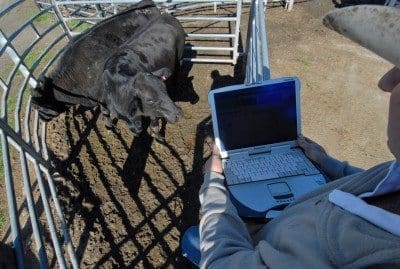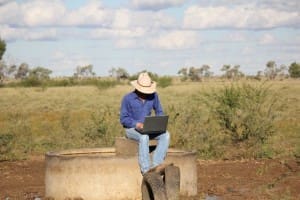 Big data. What is it, and what does it mean for agriculture, or more specifically, the Australian cattle industry?
Big data. What is it, and what does it mean for agriculture, or more specifically, the Australian cattle industry?
The term “big data” is generating a lot of interest around the world, driven by the exponential increase in the amount of digital data now being collected, the exponential decrease in the cost of computing technology to capture and process data, and the increased awareness of the potential these developments have to enhance decision-making and productivity.
In agriculture, the term Big Data has tended to become a catch-all phrase to describe all forms of ‘digital agriculture’, but strictly speaking, it refers specifically to the collection and interpretation of extremely large volumes of data, as in billions or trillions of pieces of digital information.
The broader term digital agriculture refers the use of digital technology such as sensors and monitors to collect regular and real time data from a paddock and to interpret that information to make more-informed farm-management decisions.
Digital agriculture is most commonly in use in the cropping sector, with applications recently highlighted by a Australian Farm Institute report including remote monitoring of crop performance by satellite or drones; internet-connected harvesting equipment that can constantly relay real-time crop yield and machinery performance information to off-farm data storage and interpretation dashboards; and variable rate technologies that can modify planting regimes or fertiliser application rates in response to the data collected.
However digital agriculture is also increasingly finding a place in the livestock sector for applications including electronic livestock identification systems, satellite monitoring of livestock to provide detailed feedback on mobs or individual animals, and automatic weighing and drafting systems (more on this below.
In its truest sense Big Data, as the name implies, refers specifically to the collection and interpretation of extremely large data sets, so big they require massive mainframe or cloud-based computing systems to process, far exceeding the capabilities of your average desktop or laptop computer.
Think of the millions of data points collected and stored over time when farm machinery sensors record information at points every two metres along vast rows, multiplied across every row and every field and repeated multiple times a year.
Or a drone capturing thousands of overlapping, high-resolution images of a crop or paddock, which must then be ‘stitched’ together into one final, useable map, dozens or hundreds of gigabytes in size. That calls on on a level processing grunt not available in a typical household computer.
A hypothetical example of a true “Big Data” application offered by AFI would be if every yield map generated by all grain harvesters operating in Australia in any one season were collected, and that information was combined with all the weather and soil data relevant to that growing season in each paddock, and then used to devise a formula to predict grain yields from soil and weather data.
The AFI has just completed a comprehensive, 12 month long analysis of the implications of Big Data and digital agriculture for Australian agriculture (the report can be purchased from the AFI website here)
“At this stage there are only very limited instances where true big data applications are utilised in Australian farm decision making,” the AFI report says.
Industry-level livestock sector programs that may go close to fitting under the Big Data umbrella would include the collection of data by the National Livestock Identification System, the provision of pedigree and performance information by BreedPlan to calculate Estimated Breeding Values for stud livestock, and the interpretation of carcase feedback trends under the Livestock Data Link program (this program was explained in more detail in this recent MLA article).
While debate surrounds what can truly be called ‘Big Data’ and what can not, the use of digital agriculture more generally is already proving of benefit to producers, whether the ‘Big Data’ tag is applicable or not.
The ‘third revolution’ in global agriculture
 More than just the latest soon-to-pass buzz words, digital agriculture and Big Data are set to drive “the third major revolution in agriculture”, the Australian Farm Institute believes.
More than just the latest soon-to-pass buzz words, digital agriculture and Big Data are set to drive “the third major revolution in agriculture”, the Australian Farm Institute believes.
The first was the mechanical revolution between the First and Second World Wars, and the second was the scientific revolution (often referred as the green revolution) from the late 1960s to late 1990s.
Both led to dramatic productivity increases, and it is reasonable to argue that digital agriculture will do the same, the AFI says in its recent Big Data and digital agriculture report.
Digital agriculture will enable farmers to change from paddock and herd average management, to square metre and individual animal management, with subsequent increases in farm productivity.
Productivity gains attributable to the use of digital technology have already been recorded in cropping systems of 10pc to 15pc, the AFI notes.
A recent Meat & Livestock Australia report identified four particular areas in which it believes beef and sheep livestock enterprises can benefit from the use of digital technologies:
- Soil fertility monitoring for improved pasture production;
- Feed allocation systems (allocating appropriate quality and quantity of fed to different classes of stock in a timely manner);
- Animal production monitoring (monitoring animal weight and body condition to improve reproductive performance and animal growth rates); and
- Animal disease monitoring (early detection of subclinical diseases to improve performance and welfare).
The report said existing case studies had already shown estimated productivity benefits from digital agriculture of 13-26pc for soil fertility improvements, 9-11pc for better feed allocation, 4-9pc for animal production monitoring and 4-13pc for animal health monitoring.
What do with all that data?
Many farmers have machines that are collecting data, but they are effectively swimming in more data than they know how to handle.
Farmers have had inch-accurate GPS guidance systems on tractors for 15 years. But as AgData’s technical services manager Mark Leahy recently pointed out, most farmers are still using GPS technology only as a guidance system, and are not using all of the data that is also being generated.
The key to harnessing the full benefits of digital agriculture at farm level lies in knowing what do with the data being generated.
In part at least that will rely on software providers developing useful and user-friendly dashboards that can crunch raw data into a form that is of relevance and financial value to an individual farmer’s operation.
To read how one of Australia’s largest specialist agriculture software developers views the current state of play in the digital agriculture and big data space, see part two in this series: Putting farm data to profitable use
How digital agriculture is already being used in livestock production:
The AFI report identifies several digital technologies already being introduced for the management of broadacre livestock, including:
- Auto drafters and walk over weighing platforms: Current systems with auto-drafting capability cost approximately $30,000. Average savings from walk-over weighing in CSIRO trials were estimated to be around 10pc of current mustering costs, the highest of all trialed technologies. Trials suggested the technology provided an overall average improvement of 2pc in gross margins.
- Livestock tracking systems, such as GPS tracking collars and/or tags which can then send geo-location data of livestock to a mobile device or personal computer, and video-monitoring technologies to help monitor individual animal behaviour and location.
- Remote and proximal sensors, such as the CSIRO’s Pastures from Space program, that uses satellite data to monitor pasture growth rates, feed on offer, total dry matter and greenness imagery, to provide a useful index of vegetative state. However, current limitations include cases where mixed species are involved, and in the absence of robust and detailed calibration against ground observations and data. Another example is the Sense-T system in Tasmania which uses wireless sensor systems to collect data such as soil moisture and temperature at various depths, as well as above ground temperature, relative humidity, solar radiation and leaf wetness, and sends the real-time data to a cloud storage facility, where it is aggregated with spatial and historical data. One of the key achievements of the Dairy and Beef Project component within Sense-T was the development of the Sense-T Pasture Predictor, an online tool that helps farmers to forecast future pasture growth and make better decisions in managing their herds, production and costs.
- Virtual fences: The CSIRO is currently testing a virtual fence in which no physical posts and wires are required. Livestock are confined within boundaries drawn entirely by a GPS system. The system consists of a wireless sensor network and the use of cattle neck-collars that emit a sound when the animals approach the virtual boundary. The prototype successfully demonstrated that within one hour the cattle learn to associate the sound signal from their collars with the virtual boundary.



HAVE YOUR SAY